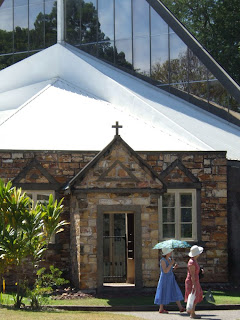 |
| Only the entrance to the church remains |
Yesterday, at the Darwin museum, a local man who lived through the cyclone gave a talk. On that night, he had put mattresses up against the windows, and taken out the life jackets for his children in case a tsunami would also join in. He thinks that as they lived by a hill, this is why their home wasn’t damaged compared to others. Not that many died, but it took many years to rebuild the town. There are no more houses on stilts as before the cyclone. This seems odd to me as I thought houses on stilts were made to withstand these types of natural catastrophes. Now, everything is fairly solid, but the houses would still probably not hold if another cyclone comes along. Most of those who were evacuated didn’t come back to the area.
 |
| What's left from the town hall |
When walking around town, the story of the cyclone is quite present. At the bank, they have pictures of the building before and after the cyclone. The church has also been rebuilt in a modern way but they’ve kept the nearby arches for an interesting layout. They also solidified the ruins of the town hall.
The Darwin museum also features indigenous art that is mostly focused on their rituals. When a child dies, they keep the bones in a small envelope until the child is reborn in the next child. If the mother doesn’t have another child, it is given to a sister so her child can be the one reborn. When this happens, they then get rid of the bones. Some of the art pieces weren’t described entirely to make sure that the rituals remain secret.
There was also a section on the cyclone and on the animals from the area, may it be the ones found in the ocean, in the trees or on the ground. They also had a stuffed crocodile that died accidently while being caught to be transferred to another habitat.
Darwin is also filled with backpackers looking for work or who are just there to enjoy the sun. The majority of them are German. In our hostel, they mostly stick together so I’m not quite sure their English is improving, mind you, that might not be why they’re here, perhaps just for the parties. Some of the bars in town cater specifically for this crowd. The Vic gives out free meal cards. Buy a drink, get a free meal. The food is ok, but then you can stick around for whatever theme is that night…ladies night with topless men and amateur strip tease contest or perhaps the bra and panties contest. Not quite my thing I must say. But I guess stripping down in a city where no one knows you to perhaps win a bit of money makes sense to these young adults. And apparently the Vic used to be called the North Australian Hotel when it was built in 1894. It survived every cyclone and bombing raid since then, and I guess it’s solid enough for what it sees every night on its dance floor :p
Another part of town that I really liked is a series of bells in the park by city hall. Each bell has a different note so you can go from one bell to another to play a tune. I guess it would be best if you had a group of people playing to avoid the silence that happens while going from one bell to another when you’re on your own.
 |
| This pedestrian crossway sign is fun |
 |
| Another Darwin resident |
Darwin est une ville où les résidents ne demeurent pas très longtemps. Soit à cause de la destruction, comme les bombardements de la 2e guerre et des cyclones, en particulier le cyclone Tracy qui a tout dévasté la veille de Noël 1974, ou bien parce que c’est la capitale d’État australienne avec le plus haut coût de la vie. Mais bon, les jeunes voyageurs sont légions. Dans mon auberge, il y a une forte présence allemande, et ça semble en fait être le cas à travers le pays.


Aucun commentaire:
Publier un commentaire